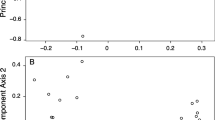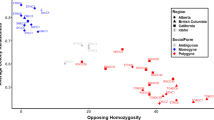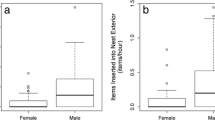Abstract
The evolution of sociality often leads to genetic structuring among groups and alters the evolutionary forces that the groups experience. Describing the genetic structuring of social species is, therefore, necessary to understand the selective forces that act on a species. While recent work has used genomic methods to investigate population structure in eusocial insects, relatively little genomic work has examined population structure in the largest non-human mammal and avian clades. We delimited population genetic structuring in Sociable Weavers (Philetairus socius), a passerine that lives in large, stable, perennial colonies, using the genotyping-by-sequencing approach to generate a dataset of several thousand SNPs. We used the SNPs to estimate genetic structuring within and among eight nests. While we document relatively low levels of genetic structuring among nests, the structuring was not explained by distance between nests. We also found significantly higher structuring among male Sociable Weavers compared to female weavers, suggesting that female Sociable Weavers are more prone to dispersal in this species. Not all nests represent distinct genetic groups according to Bayesian clustering analysis, which is unsurprising given the low differentiation among nests, especially compared to other social species. In almost all colonies there was less heterozygosity than expected, possibly due to reproductive skew within each colony.
Zusammenfassung
Populationsgenomik von Siedelwebern ( Philetairus socius ) zeigt beträchtliche Vermischung zwischen Kolonien Die Evolution von Sozialität führt oftmals zu einer genetischen Strukturierung zwischen Gruppen und verändert die evolutiven Kräfte, welche die Gruppen erfahren. Eine Beschreibung der genetischen Strukturierung sozialer Arten ist daher notwendig, um zu verstehen, welche Selektionskräfte auf eine Art wirken. Während neuere Arbeiten genomische Methoden verwendet haben, um die Populationsstruktur eusozialer Insekten zu untersuchen, gibt es bislang nur relativ wenige genomische Arbeiten zur Populationsstruktur in den größten nicht-humanen Säuger- und Vogelkladen. Wir haben die genetische Populationsstruktur beim Siedelweber (Philetairus socius) abgesteckt, einem Sperlingsvogel, der in großen, stabilen, mehrjährigen Kolonien lebt. Wir haben den Genotypisierung-durch-Sequenzierung-Ansatz verwendet, um einen aus mehreren Tausend SNPs bestehenden Datensatz zu generieren. Wir haben die SNPs verwendet, um die genetische Strukturierung innerhalb und zwischen acht Nestern abzuschätzen. Wir dokumentieren ein relativ niedriges Ausmaß genetischer Strukturierung zwischen Nestern, was nicht durch die Entfernung zwischen den Nestern erklärt werden kann. Wir fanden signifikant stärkere Strukturierung zwischen männlichen Siedelwebern als zwischen weiblichen Siedelwebern, was darauf hindeutet, dass weibliche Siedelweber eher zur Abwanderung neigen. Gemäß einer Bayesschen Clusteranalyse stellen nicht alle Nester distinkte genetische Gruppen dar, was angesichts der besonders im Vergleich zu anderen sozialen Arten geringen Differenzierung zwischen Nestern nicht überraschend ist. In fast allen Kolonien war die Heterozygosität geringer als erwartet, möglicherweise aufgrund von reproduktiver Asymmetrie innerhalb jeder Kolonie.





Similar content being viewed by others
References
Agnarsson I, Aviles L, Maddison WP (2013) Loss of genetic variability in social spiders: genetic and phylogenetic consequences of population subdivision and inbreeding. J Evol Biol 26:27–37
Altwegg R, Doutrelant C, Anderson MD, Spottiswoode CN, Covas R (2014) Climate, social factors and research disturbance influence population dynamics in a declining sociable weaver metapopulation. Oecologia 174:413–425
Baldassarre DT, White TA, Karubian J, Webster MS (2014) Genomic and morphological analysis of a semipermeable avian hybrid zone suggests asymmetrical introgression of a sexual signal. Evolution 68:2644–2657
Beck NR, Peakall R, Heinsohn R (2008) Social constraint and an absence of sex-biased dispersal drive fine-scale genetic structure in white-winged choughs. Mol Ecol 17:4346–4358
Blackmore CJ, Peakall R, Heinsohn R (2011) The absence of sex-biased dispersal in the cooperatively breeding grey-crowned babbler. J Anim Ecol 80:69–78
Braude S (2000) Dispersal and new colony formation in wild naked mole-rats: evidence against inbreeding as the system of mating. Behav Ecol 11:7–12
Brown C, Covas R, Anderson M, Brown M (2003) Multistate estimates of survival and movement in relation to colony size in the sociable weaver. Behav Ecol 14:463–471
Burland TM, Bennett NC, Jarvis JU, Faulkes CG (2002) Eusociality in African mole-rats: new insights from patterns of genetic relatedness in the Damaraland mole-rat (Cryptomys damarensis). Proc R Soc Lond B 269:1025–1030
Bush K, Vinsky M, Aldridge C, Paszkowski C (2005) A comparison of sample types varying in invasiveness for use in DNA sex determination in an endangered population of greater Sage-Grouse (Centrocercus uropihasianus). Conserv Genet 6:867–870
Callens T, Galbusera P, Matthysen E, Durand EY, Githiru M, Huyghe JR, Lens L (2011) Genetic signature of population fragmentation varies with mobility in seven bird species of a fragmented Kenyan cloud forest. Mol Ecol 20:1829–1844
Charlesworth D (2003) Effects of inbreeding on the genetic diversity of populations. Proc R Soc Lond B 358:1051–1070
Covas R, Doutrelant C, du Plessis M (2004) Experimental evidence of a link between breeding conditions and the decision to breed or to help in a colonial cooperative bird. Proc R Soc Lond B 271:827–832
Covas R, Dalecky A, Caizergues A, Doutrelant C (2006) Kin associations and direct vs indirect fitness benefits in colonial cooperatively breeding sociable weavers Philetairus socius. Behav Ecol Sociobiol 60:323–331
Davey JW, Hohenlohe PA, Etter PD, Boone JQ, Catchen JM, Blaxter ML (2011) Genome-wide genetic marker discovery and genotyping using next-generation sequencing. Nat Rev Genet 12:499–510
Diniz-Filho J, Soares T, Lima J, Dobrovolski R, Landeiro V, de Campos Telles M, Rangel T, Bini L (2013) Mantel test in population genetics. Genet Mol Biol 36:475–485
Dor R, Safran RJ, Vortman Y, Lotem A, McGowan A, Evans MR, Lovette IJ (2012) Population genetics and morphological comparisons of migratory European (Hirundo rustica rustica) and sedentary East-Mediterranean (Hirundo rustica transitiva) barn swallows. J Hered 103:55–63
Dray S, Du-four A, Thiolouse J (2014) ade4, CRAN
Ellegren H, Smeds L, Burri R, Olason PI, Backstrom N, Kawakami T, Kunstner A, Makinen H, Nadachowska-Brzyska K, Qvarnstrom A, Uebbing S, Wolf JB (2012) The genomic landscape of species divergence in Ficedula flycatchers. Nature 491:756–760
Elshire RJ, Glaubitz JC, Sun Q, Poland JA, Kawamoto K, Buckler ES, Mitchell SE (2011) A robust, simple genotyping-by-sequencing (GBS) approach for high diversity species. PLoS One 6:e19379
Evanno G, Regnaut S, Goudet J (2005) Detecting the number of clusters of individuals using the software STRUCTURE: a simulation study. Mol Ecol 14:2611–2620
Faulkes CG, Abbott DH, O’Brien HP, Lau L, Roy MR, Wayne RK, Bruford MW (1997) Micro- and macrogeographical genetic structure of colonies of naked mole-rats Heterocephalus glaber. Mol Ecol 6:615–628
Fisher RA (1930) The genetical theory of natural selection. Clarendon Press, Oxford
Glaubitz JC, Casstevens T, Lu F, Harriman J, Elshire RJ, Sun Q, Buckler ES (2014) TASSEL-GBS: a high capacity genotyping by sequencing analysis pipeline. PLoS One 9:e90346
Haag-Liautard C, Vitikainen E, Keller L, SundstrÖM L (2009) Fitness and the level of homozygosity in a social insect. J Evol Biol 22:134–142
Hamilton W (1964) Genetical evolution of social behaviour I. J Theor Biol 7:1–16
Han J-I, Kim J-H, Kim S, Park S-R, Na K-J (2009) A simple and improved DNA test for avian sex determination. Auk 126:779–783
Harrison XA, York JE, Young AJ (2014) Population genetic structure and direct observations reveal sex-reversed patterns of dispersal in a cooperative bird. Mol Ecol 23:5740–5755
Hedrick P (2010) Genetics of populations. Jones & Bartlett Learning, Burlington
Hoglund J, Shorey L (2004) Genetic divergence in the superspecies Manacus. Biol J Linn Soc 81:439–447
Hubisz M, Falush D, Stephens M, Pritchard J (2009) Inferring weak population structure with the assistance of sample group information. Mol Ecol Res 5:1322–1332
Lebigre C, Alatalo RV, Forss HE, Siitari H (2008) Low levels of relatedness on black grouse leks despite male philopatry. Mol Ecol 17:4512–4521
Leighton GM (2014) Sex and individual differences in cooperative nest construction of sociable weavers. J Ornithol 155:927–935
Leighton GM, Echeverri S (2014) Non-linear influence of nest size on thermal buffering of sociable weaver nests and the maintenance of cooperative nest construction. Avian Biol Res 7:255–260
Leighton GM, Echeverri S (2015) Stable isotope signatures reveal cryptic differences in diet of sociable weavers. Avian Biol Res 8:104–108
Loecher, M. 2014: RgoogleMaps
Maclean G (1973) The sociable weaver (Parts 1-5). Ostrich 44:176–216
McRae S, Emlen S, Rubenstein D, Bogdanowicz S (2005) Polymorphic mircosatellite loci in a plural breeder, the grey-capped social weaver (Pseudonigrita arnaudi), isolated with an improved enrichment protocol using fragment size-selection. Mol Ecol Notes 5:16–20
Neel M, McKelvey K, Ryman N, Lloyd M, Short Bull R, Allendorf F, Schwartz M, Waples R (2013) Estimation of effective population size in continuously distributed populations: there goes the neighborhood. Heredity 111:189–199
Nichols HJ, Jordan NR, Jamie GA, Cant MA, Hoffman JI (2012) Fine-scale spatiotemporal patterns of genetic variation reflect budding dispersal coupled with strong natal philopatry in a cooperatively breeding mammal. Mol Ecol 21:5348–5362
Nichols HJ, Cant MA, Hoffman JI, Sanderson JL (2014) Evidence for frequent incest in a cooperatively breeding mammal. Biol Lett 10:1–4
Nogueira DM, Pope LC, Burke T, Alves MAS (2014) Genetic differentiation over a short water barrier in the Brazilian tanager, Ramphocelus bresilius (Passeriformes: Thraupidae) an endemic species of the Atlantic forest. Brazil Conserv Genet 15:1151–1162
Peters JL, Bolender KA, Pearce JM (2012) Behavioural vs. molecular sources of conflict between nuclear and mitochondrial DNA: the role of male-biased dispersal in a Holarctic sea duck. Mol Ecol 21:3562–3575
Pritchard J, Stephens M, Donnelly P (2000) Inference of population structure using multilocus genotype data. Genetics 155:945–959
R Core Team Development. 2014: R: a language and environment for statistical computing. R Foundation for Statistical Computing, Vienna, Austria. URL www.R-project.org/
Reeve H, Westneat DF, Noon W, Sherman PW, Aquadro C (1990) DNA “fingerprinting” reveals high levels of inbreeding in colonies of eusocial naked mole-rat. P Natl Acad Sci USA 87:2496–2500
Romiguier J, Lourenco J, Gayral P, Faivre N, Weinert LA, Ravel S, Ballenghien M, Cahais V, Bernard A, Loire E, Keller L, Galtier N (2014) Population genomics of eusocial insects: the costs of a vertebrate-like effective population size. J Evol Biol 27:593–603
Rosenberg N (2004) DISTRUCT: a program for the graphical display of population structure. Mol Ecol Notes 4:137–138
Ross KG (2001) Molecular ecology of social behaviour: analyses of breeding systems and genetic structure. Mol Ecol 10:265–284
Rousset F (1997) Genetic differentiation and estimation of gene flow from F-statistics under isolation by distance. Genetics 145:1219–1228
Rousset F (2008) Genepop’007: a complete reimplementation of the Genepop software for Windows and Linux. Mol Ecol Res 8
Schuttler S, Philbrick J, Jeffrey K, Eggert L (2014) Fine-scale genetic structure and cryptic assocations reveal evidence of kin-based sociality in the african forest elephant. PLoS One 9:e88074
Sokal R, Rohlf F (1995) Biometry. W.H. Freeman and Company
Taylor SA, Curry RL, White TA, Ferretti V, Lovette I (2014) Spatiotemporally consistent genomic signatures of reproductive isolation in a moving hybrid zone. Evolution 68:3066–3081
van Dijk R, Kaden J, Argüelles-Tico A, Beltran M, Paquet M, Covas R, Doutrelant C, Hatchwell B (2013) The thermoregulatory benefits of the communal nest of sociable weavers Philetairus socius are spatially structured within nests. J Avian Biol 44:102–110
van Dijk R, Kaden JC, Arguelles-Tico A, Dawson DA, Burke T, Hatchwell BJ (2014) Cooperative investment in public goods is kin directed in communal nests of social birds. Ecol Lett 17:1141–1148
van Dijk RE, Covas R, Doutrelant C, Spottiswoode CN, Hatchwell BJ (2015) Fine-scale genetic structure reflects sex-specific dispersal strategies in a population of sociable weavers (Philetairus socius). Mol Ecol 24:4296–4311
Wahlund S (1928) Zusammensetzung von populationen und korrelation-serscheinungen von standpunkt der verebungslehre aus betrachtet. Hereditas 11:65–106
Walsh J, Kovach AI, Babbitt KJ, O’Brien KM (2012) Fine-scale population structure and asymmetrical dispersal in an obligate salt-marsh passerine, the Saltmarsh Sparrow (Ammodramus caudacutus). Auk 129:247–258
Weir B, Cockerham C (1984) Estimating F-statistics for the analysis of population structure. Evolution 38:1358–1370
Wilson DS, Pollock GB, Dugatkin L (1992) Can altruism evolve in purely viscous populations. Evol Ecol 6:331–341
Woxvold IA, Adcock GJ, Mulder RA (2006) Fine-scale genetic structure and dispersal in cooperatively breeding apostlebirds. Mol Ecol 15:3139–3146
Acknowledgments
We thank William Searcy and other members of the Department of Biology for the constructive suggestions that improved this paper. We thank Elizabeth Cooper for providing guidance on the bioinformatics software and we thank Cornell’s Institute for Genomic Diversity for assistance with NGS. We thank Dirk Heinrich and Holger Kolberg for support carrying out the field work. This work was funded via a National Science Foundation Doctoral Dissertation Improvement Grant (#121500), funding from the University of Miami College of Arts and Sciences, and funding from the William Maytag Endowment. The University of Miami IACUC (permit number: 12-098) and the Ministry of Environment and Tourism (permit number: 1866) provided permits that allowed for this work. The work was performed on private land in central Namibia. We followed the ethics of IACUC and the Animal Behavior Society in performing this work. We thank two anonymous reviewers for suggestions that improved the manuscript.
Data accessibility
All raw data will be deposited in NCBI’s short read sequence archive.
Author information
Authors and Affiliations
Corresponding author
Additional information
Communicated by M. Wink.
Electronic supplementary material
Below is the link to the electronic supplementary material.
Rights and permissions
About this article
Cite this article
Leighton, G.M., Echeverri, S. Population genomics of Sociable Weavers Philetairus socius reveals considerable admixture among colonies. J Ornithol 157, 483–492 (2016). https://doi.org/10.1007/s10336-015-1307-1
Received:
Revised:
Accepted:
Published:
Issue Date:
DOI: https://doi.org/10.1007/s10336-015-1307-1




